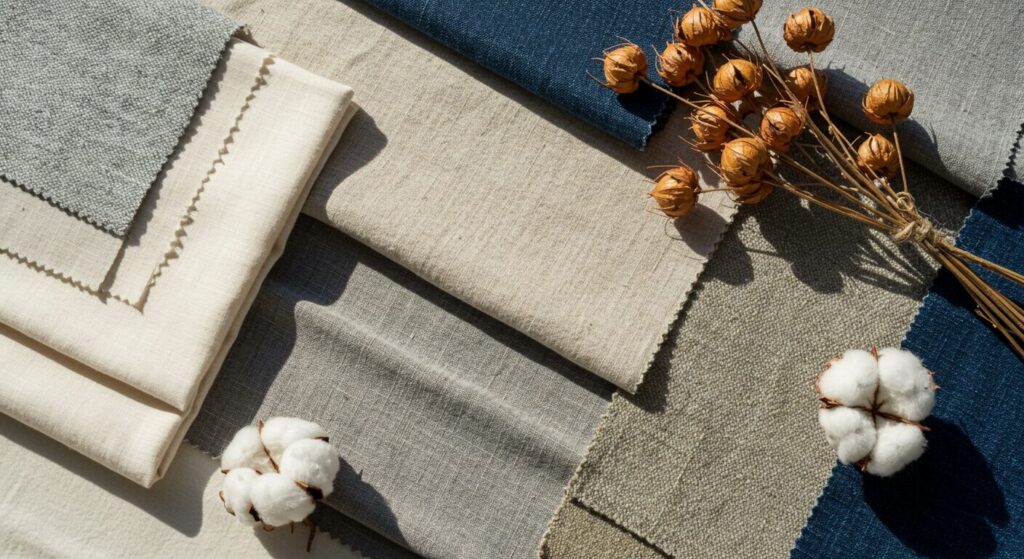
Hey Change-Makers! Every single day, we make choices that ripple outwards. From the food we eat to the transportation we choose, our decisions shape the world around us. And yes, that absolutely includes the clothes we wear. Think about it: fabric is the very foundation of fashion. And the type of fabric? That’s where we have real power to create positive change.
For too long, the fashion industry has relied heavily on materials and processes that strain our planet and its resources. But there’s a powerful shift happening, driven by innovation, awareness, and a growing demand for better choices. That shift is eco-friendly materials.
Why Eco-Friendly Materials Matter: A Deep Dive
Choosing eco-friendly materials isn’t just a trend; it’s a fundamental step towards a sustainable fashion future. It’s about understanding the lifecycle of our clothes – from the raw materials to their eventual disposal – and opting for options that minimize harm at every stage. Here’s why it’s so vital:
- Reducing Environmental Impact: Conventional textile production is resource-intensive and polluting. Eco-friendly materials aim to drastically reduce:
- Water Consumption: Conventional cotton farming, for example, is notoriously water-intensive. [^1] Eco-alternatives like linen and hemp often require significantly less water.
- Pesticide & Herbicide Use: Conventional cotton also relies heavily on harmful pesticides and herbicides, impacting biodiversity and human health. [^2] Organic cotton and other natural fibers grown with sustainable practices minimize or eliminate these chemicals.
- Chemical Pollution: Conventional dyeing and processing often involve toxic chemicals that pollute waterways and can be harmful to workers and consumers. [^3] Eco-friendly materials often utilize natural dyes and closed-loop production systems.
- Greenhouse Gas Emissions: The production of synthetic fibers like polyester, derived from fossil fuels, contributes significantly to carbon emissions. [^4] Eco-alternatives like plant-based and recycled fibers offer lower-carbon options.
- Textile Waste: Fast fashion’s reliance on cheap, short-lived fabrics fuels massive textile waste in landfills. [^5] Eco-friendly materials often prioritize durability and recyclability, moving towards a circular economy.
- Promoting Ethical Practices: Eco-friendliness and ethical production often go hand-in-hand. Sustainable materials can support:
- Fair Labor Standards: Supporting farmers and workers who are paid fairly and work in safe conditions.
- Improved Farmer Livelihoods: Organic and sustainable farming practices can enhance soil health and long-term farm viability, improving livelihoods for farming communities.
- Healthier Communities: Reducing exposure to harmful chemicals in textile production benefits both workers and communities living near production facilities.
Let’s Explore the Fabric Landscape: Key Eco-Friendly Material Categories
To empower you to make informed choices, let’s explore some key categories and examples of eco-friendly materials. For each, we’ll highlight benefits, considerations, and provide links to credible resources for deeper dives.
1. Plant-Based Wonders: Grown with the Earth in Mind
These fabrics come from renewable plant sources, often grown using sustainable agricultural practices.
- Organic Cotton:
- Benefits: Grown without synthetic pesticides, herbicides, or GMOs, promoting soil health and biodiversity, reducing exposure to harmful chemicals for farmers and ecosystems. Often softer than conventional cotton.
- Considerations: Organic cotton farming can still be water-intensive (though often less so than conventional in optimized systems) and requires land use. “Organic” certifications (like GOTS) are crucial to verify true organic practices.
- Uses: T-shirts, jeans, underwear, bedding, towels, baby clothes, home textiles.
- Research & Resources:
- Global Organic Textile Standard (GOTS): https://www.global-standard.org/ (Leading standard for organic textiles, covering environmental and social criteria. [Research GOTS Standards & Impact Reports on their website])
- Textile Exchange – Organic Cotton: https://textileexchange.org/materials/organic-cotton/ (Industry data, reports, and resources on organic cotton. [Explore their Market Reports & Data])
- FAO – Organic Agriculture: https://www.fao.org/organicag/oa-faq/oa-faq8/en/ (FAO resources on the benefits of organic agriculture, including cotton farming. [Search FAO for publications on Organic Cotton])
- Linen (Flax):
- Benefits: Highly sustainable crop, requires significantly less water and pesticides than cotton, naturally resilient, biodegradable, strong and durable fabric, breathable, becomes softer with wash.
- Considerations: Flax cultivation is geographically limited. Processing can be energy-intensive, but sustainable methods exist.
- Uses: Clothing (shirts, dresses, trousers, suits), home textiles (bedding, tablecloths, curtains), towels.
- Research & Resources:
- European Confederation of Linen and Hemp (CELC): https://www.europeanflax.com/en/ (Information on European Flax production, sustainability, and LCA studies. [Look for their Sustainability Section & LCA Data])
- Linen Fabric Guide by Sewport: https://sewport.com/fabrics-directory/linen-fabric (Comprehensive guide including environmental aspects. [Review Sewport’s “Sustainability” section within the Linen Guide])
- Hemp:
- Benefits: Extremely sustainable crop, grows quickly, very low water and pesticide needs, naturally pest-resistant, improves soil health, high carbon sequestration, strong and durable fiber, UV protective.
- Considerations: Hemp processing can be complex, though improving. Regulations on hemp cultivation vary. Texture can be coarser, but processing can create softer versions.
- Uses: Clothing (workwear, outerwear, casual wear), bags, shoes, home textiles, industrial applications.
- Research & Resources:
- Journal of Industrial Hemp: https://www.tandfonline.com/toc/wjih20/current (Academic journal publishing research on hemp, including sustainable cultivation and fiber properties. [Search for articles on “hemp sustainability” or “hemp environmental impact”])
- Vote Hemp: http://www.votehemp.com/ (Advocacy organization with resources on hemp benefits and industry development. [Explore their “Hemp Facts” & “Sustainability” sections])
- Lyocell (e.g., Tencel™):
- Benefits: Closed-loop production (solvents recycled), sustainably sourced wood pulp (eucalyptus, beech, birch – look for FSC or PEFC certification), significantly reduces water and chemical waste, soft, breathable, moisture-wicking, biodegradable.
- Considerations: Wood pulp sourcing must be from sustainably managed forests.
- Uses: Clothing (lingerie, activewear, dresses, blouses, t-shirts), bedding, home textiles.
- Research & Resources:
- Tencel™ Website (Lenzing Group): https://www.tencel.com/ (Detailed sustainability info from the Lyocell brand manufacturer, including LCA data and closed-loop process details. [Explore their “Sustainability” section and certifications])
- Forest Stewardship Council (FSC): https://fsc.org/en (Certification for responsibly managed forests, relevant to wood pulp sourcing. [Search their database for FSC-certified forests and products])
2. Recycled Revolution: Giving Waste a New Life
These fabrics are made from pre-existing materials, reducing landfill waste and the need for virgin resources.
- Recycled Cotton:
- Benefits: Reduces landfill waste, lowers demand for virgin cotton, lower water and energy footprint compared to virgin cotton production, often blended for strength.
- Considerations: Recycling processes vary in environmental impact. Quality and softness can vary.
- Uses: Jeans, t-shirts, sweatshirts, insulation, filling.
- Research & Resources:
- Recover™: https://recovertex.com/ (Example company focused on recycled cotton fiber. [Explore their “Sustainability” and “Process” pages])
- Council for Textile Recycling (CTR): https://www.weardonateretex.org/ (US-based organization, data and info on textile recycling. [Check their “Resources” and “Facts & Figures” sections])
- Recycled Polyester (rPET):
- Benefits: Diverts plastic bottles from landfills/oceans, reduces reliance on virgin petroleum, significantly lower energy consumption than virgin polyester.
- Considerations: Recycling process still uses energy. Microplastic shedding is a concern (same as virgin polyester). Not biodegradable.
- Uses: Outerwear, activewear, fleece, linings, bags, shoes, stuffing.
- Research & Resources:
- Textile Exchange – Recycled Polyester: https://textileexchange.org/materials/recycled-polyester/ (Industry overview, data, and standards for recycled polyester. [Explore their “Recycled Polyester” section])
- Plastic Oceans International: https://plasticoceans.org/ (Organization working on plastic pollution solutions, including textile impacts and rPET. [Search their site for “textiles” or “microplastics”])
3. Innovative Frontiers: Exploring New Possibilities
Exciting materials pushing boundaries in sustainability and circularity.
- Piñatex® (Pineapple Leaf Leather):
- Benefits: Utilizes agricultural waste (pineapple leaves), reduces reliance on animal leather, lower water/land needs than animal agriculture, vegan alternative.
- Considerations: Newer material, smaller production scale, durability compared to leather still being assessed long-term, current versions use a petroleum-based resin coating (bio-based alternatives in development).
- Uses: Shoes, bags, accessories, upholstery, clothing details.
- Research & Resources:
- Piñatex® Official Website: https://www.ananas-anam.com/ (Detailed info from the creators, including sustainability and production process. [Explore their “Sustainability” and “Materials” pages])
- Material Innovation Initiative (MII): https://materialinnovation.org/ (Organization promoting next-gen materials, often featuring plant-based leather alternatives. [Search their site for “Piñatex” or “plant-based leather”])
(Further Exploration Encouraged): Research materials like mushroom leather (Mylo™, MuSkin), seaweed fabric (SeaCell™), orange fiber, and cork fabric. These offer unique sustainable benefits and are part of the evolving landscape of eco-textiles.
Your Choice Matters: Weave a Sustainable Future
Choosing eco-friendly materials is a powerful act. It’s a vote for a healthier planet, fairer practices, and a more conscious fashion industry. It’s about making informed decisions, supporting innovation, and embracing a style that aligns with our values.
This is just the beginning of your journey into eco-fabrics! Explore the links provided, delve deeper into research, and most importantly, start asking questions about the materials in your clothes. Every step, every conscious choice, makes a difference. Let’s weave a more sustainable future, thread by thread!


Leave a Reply